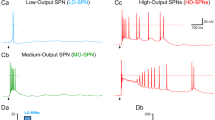Summary
The effects of two supraspinal systems on transmission through a short latency hindlimb cutaneous reflex pathway were studied in cats anesthetized with pentobarbital or α-chloralose. Fleshman et al. (1984) described a mixed excitatoryinhibitory input from low threshold superficial peroneal (SP) afferents to flexor digitorum longus (FDL) motoneurons with central latencies so short as to suggest a disynaptic component in the initial excitatory phase of the PSP. In the present study, conditioning stimulation of either the red nucleus (RN) or the pyramidal tract (PT) caused a marked decrease in latency and increase in amplitude of both the excitatory and inhibitory components of the SP PSP in FDL motoneurons and several other motoneuron species. The minimal central latencies of the conditioned initial excitatory phase of the PSPs were on the order of 1.5 ms, consistent with the possibility of a disynaptic linkage. The facilitatory effects of RN and PT conditioning were observed in both anesthetic conditions, although preparation-specific differences in latency were observed. Lesion experiments suggested that the interneurons involved in this pathway are located caudal to the L5 segment, most likely in segments L6 and L7.
Similar content being viewed by others
References
Baldissera F, ten Bruggencate G, Lundberg A (1971) Rubrospinal monosynaptic connexion with last-order interneurones of polysynaptic reflex paths. Brain Res 27: 390–392
Baldissera F, Hultborn H, Illert M (1981) Integration in spinal neuronal systems. In: Brooks VB (ed) Handbook of physiology, Sect 1. The nervous system, Vol II. Motor control, Part 1. American Physiological Society, Bethesda, pp 509–595
Baldissera F, Lundberg A, Udo M (1972) Stimulation of pre- and postsynaptic elements in the red nucleus. Exp Brain Res 15: 151–167
Bernhard CG (1953) The spinal cord potentials in leads from the cord dorsum in relation to peripheral source of afferent stimulation. Acta Physiol Scand 29, Suppl 106: 1–29
Brown AG (1981) Organization in the spinal cord: the anatomy and physiology of identified neurones. Springer, Berlin Heidelberg New York, 238 pp
Burke RE, Fleshman JW (1986) Strategies to identify interneurons involved in locomotor pattern generation in the mammalian spinal cord. In: Grillner S, Stein PSG, Stuart DG, Forssberg H, Herman R (eds) Neurobiology of vertebrate locomotion. Wenner-Gren International Symposium 45. Macmillan, London, pp 245–268
Cavallari P, Edgley SA, Jankowska E (1987) Postsynaptic actions of mid-lumbar interneurones on motoneurones of hindlimb muscles in the cat. J Physiol (Lond) 389: 675–689
Chang SC, Wei JY, Mao CP (1983) Deep innervation of sural nerve. Brain Res 279: 262–265
Coombs JS, Curtis DR, Landgren S (1956) Spinal cord potentials generated by impulses in muscle and cutaneous afferents fibers. J Neurophysiol 19: 452–467
Eccles JC, Eccles RM, Lundberg A (1957) Synaptic actions on motoneurones caused by impulses in Golgi tendon organ afferents. J Physiol (Lond) 138: 227–252
Eccles JC, Fatt P, Landgren S (1956) Central pathway for direct inhibitory action of impulses in largest afferent nerve fibres to muscle. J Neurophysiol 19: 75–98
Fleshman JW, Lev-Tov A, Burke RE (1984) Peripheral and central control of flexor digitorum longus and flexor hallucis longus motoneurons: the synaptic basis of functional diversity. Exp Brain Res 54: 133–149
Fleshman JW, Rudomin P, Burke RE (1985) Supraspinal conditioning of short-latency pathways to lumbar motoneurons. Soc Neurosci Abstr 11: 401
Hongo T, Jankowska E, Lundberg A (1969) The rubrospinal tract. II. Facilitation of interneuronal transmission in reflex paths to motoneurones. Exp Brain Res 7: 365–391
Hongo T, Jankowska E, Lundberg A (1972) The rubrospinal tract. IV. Effects on interneurones. Exp Brain Res 15: 54–78
Illert M, Lundberg A, Padel Y, Tanaka R (1978) Integration in descending motor pathways controlling the forelimb in the cat. 5. Properties of and monosynaptic excitatory convergence on C3–C4 propriospinal neurones. Exp Brain Res 33:101–130
Illert M, Lundberg A, Tanaka R (1976) Integration in descending motor pathways controlling the forelimb in the cat. 2. Convergence on neurones mediating disynaptic cortico-motoneuronal excitation. Exp Brain Res 26: 521–540
Lundberg A (1969) Convergence of excitatory and inhibitory action on interneurones in the spinal cord. In: Brazier MAB (ed) The interneuron. UCLA Forum in Medical Sciences, Number 11. Univ Calif Press, Berkeley, pp 231–265
Lundberg A (1975) Control of spinal mechanisms from the brain. In: Tower DB (ed) The nervous system, Vol 1. The basic neurosciences. Raven Press, New York, pp 253–265
Lundberg A (1979) Multisensory control of spinal reflex pathways. In: Granit R, Pompeiano O (eds) Reflex control of posture and movement. Elsevier, Amsterdam, pp 11–28
Meyers D, Fleshman JW, Schmidt BJ (1985) Retrograde labeling of spinal neurons following injection of HRP into the flexor digitorum longus motor nucleus in the cat. Soc Neurosci Abstr 11:26
Omeniuk DJ, Schmidt BJ, Burke RE (1986) Central latencies of PSPs evoked by low threshold cutaneous afferents in cat α-motoneurons. Soc Neurosci Abstr 12: 248
Pinter MJ, Burke RE, O'Donovan MJ, Dum RP (1982) Supraspinal facilitation of cutaneous polysynaptic EPSPs in cat medial gastrocnemius motoneurons. Exp Brain Res 45: 133–143
Rosenberg ME (1970) Synaptic connexions of alpha extensor motoneurones with ipsilateral and contralateral cutaneous nerves. J Physiol (Lond) 207: 231–255
Schmidt BJ, Meyers D, Tokuriki M, Fleshman JW, Burke RE (1986) Modulation of short latency EPSPs from cutaneous afferents fo FDL motoneurons during fictive locomotion in the cat. Soc Neurosci Abstr 12: 884
Schmidt EM (1982) Computer control of the Nicolet 1170 signal averager. J Neurosci Meth 6: 273–279
Sherrington CS (1929) Some functional problems attaching to convergence. Ferrier Lecture. Proc R Soc 105B: 332–362
Weakly JN (1969) Effect of barbiturates on ‘quantal’ synaptic transmission in spinal motoneurones. J Physiol (Lond) 204: 63–77
Willis WD, Weir MA, Skinner RD, Bryan RN (1973) Differential distribution of spinal cord field potentials. Exp Brain Res 17: 169–176
Author information
Authors and Affiliations
Rights and permissions
About this article
Cite this article
Fleshman, J.W., Rudomin, P. & Burke, R.E. Supraspinal control of a short-latency cutaneous pathway to hindlimb motoneurons. Exp Brain Res 69, 449–459 (1988). https://doi.org/10.1007/BF00247299
Received:
Accepted:
Issue Date:
DOI: https://doi.org/10.1007/BF00247299




